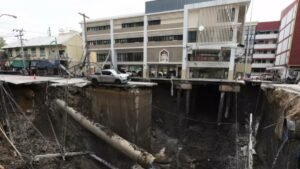Record-breaking tsunami: waves towering as tall as a forest causing widespread destruction

Although tsunamis are usually associated with giant waves that sweep coasts and cities, one in particular stands out above the rest. It is a phenomenon that occurred in an isolated bay in Alaska in 1958, where nature unleashed an unprecedented force. Beyond the devastation, what is striking is the size of the wave: a height that exceeds that of the Eiffel Tower. In this article, we explore what really happened that day, why that wave was so colossal, and how it compares to other tsunamis that have marked humanity.
### A remote corner that became the epicenter of terror
In July 1958, Lituya Bay, a narrow fjord located on the Pacific coast of Alaska, was the scene of the largest tsunami ever recorded. Surrounded by mountains and glaciers, this 14.5 km long by 3.2 km wide bay seemed like a peaceful place, until a magnitude 7.8 earthquake unleashed a colossal avalanche.
Between 35 and 40 million cubic meters of rocks and ice broke off from a height of 600 meters and fell directly into the water. The energy of the impact was so immense that it lifted a wave 524 meters high, sweeping everything in its path, including a dense forest located on the opposite slope. It was not a wave that traveled great distances, but an explosive force that rose like a liquid wall.
Experts consider this to be the highest “run-up” ever measured: that is, the highest elevation that the water reached above sea level in a tsunami. And although it did not leave a high number of victims—due to the low population density of the area— its magnitude positions it as a unique event in the records.
### What sets this tsunami apart from other catastrophic events
Over the centuries, dozens of mega-tsunamis have occurred and been documented by scientists and historians. A global catalog has identified at least 40 since 1674. Some of them also recorded waves that exceeded 100 meters, but none matched the mark of the Lituya event.
The curious thing is that, despite its unprecedented size, this tsunami is not among the most deadly. This is because it occurred in a practically uninhabited area. However, it did leave crucial lessons for the scientific community, especially regarding the relationship between earthquakes, avalanches, and tsunamis in closed fjords.
### The deadliest and costliest tsunamis in modern history
Although the Lituya tsunami was the highest, other tsunamis have left a much more devastating impact in human and economic terms. According to the , some of the most significant ones include:
– **Indian Ocean (2004):** caused by a magnitude 9.1 earthquake, it resulted in over 227,000 deaths in countries like Indonesia, Sri Lanka, India, and Thailand. It is considered the deadliest in history.
– **Japan (2011):** another magnitude 9.1 earthquake generated a tsunami that left over 18,000 victims and estimated damages of 243.000 billion dollars, becoming the most expensive natural disaster on record.
These cases show that the height of a wave does not always determine its destructive level. Factors such as population density, infrastructure, and local preparedness can make the difference between an extraordinary natural event and a tragedy of historical proportions.
## A warning from the past that remains relevant
The Lituya Bay megatsunami stands as a striking reminder of what the Earth is capable of in a matter of seconds. Although not the deadliest, its power defies imagination. Studying these types of phenomena not only helps us understand natural risks, but also prepares us for future scenarios, even in the most remote corners of the planet.
[Source: ]







